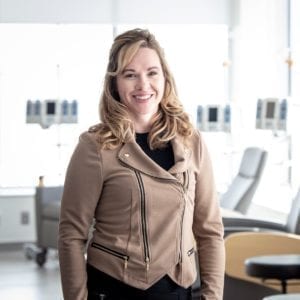 Danielle McCully is helping to open new avenues of research into inherited blood disorders. She has a unique understanding of this family of diseases. Her father had severe hemophilia A and died at 35 from tainted blood. She carries the gene for this disease, and both of her children have hemophilia. And more recently, she was diagnosed with another bleeding disorder, von Willebrand disease.
Danielle McCully is helping to open new avenues of research into inherited blood disorders. She has a unique understanding of this family of diseases. Her father had severe hemophilia A and died at 35 from tainted blood. She carries the gene for this disease, and both of her children have hemophilia. And more recently, she was diagnosed with another bleeding disorder, von Willebrand disease.
But it was her own diagnosis of mild hemophilia in her early 20s that set her on the path to finding better ways to diagnose and treat this disease. She works closely with Dr. Paula James, a clinician-scientist at Kingston Health Sciences Centre and one of Canada’s foremost experts on inherited bleeding disorders, particularly bleeding disorders in women. Danielle is a frequent participant in Dr. James’s research and she does outreach and education on living with bleeding disorders. Here’s her story:
“For a long time we’ve understood only that hemophilia is a male disorder. After I was diagnosed, it explained so much to me – not just having heavy periods, but remembering that as a child, I was always covered in bruises. The bleeding affected my joints – I had ankle injuries. I also had iron deficiency, which meant I was extremely tired, suffered from lack of motivation. It affected my moods and created anxiety as well. So the diagnosis was reassuring, and a positive thing. It opened up my eyes. I remember thinking, this a big thing, but I’ve lived this long with it and done OK. Many women live for 12-14 years with bleeding disorders before being diagnosed.
I’ve been taking part in Dr. James’s research for about 10 years, including studies on hemophilia symptoms in female carriers, and on self-reporting and physical mobility. I do it because I want to impact quality of life for women with bleeding disorders.
After we were married my husband were referred to genetic counselling because we wanted to find out more about living with hemophilia and we had all the information before we decided to have kids.
Part of my decision to take part in research goes back to my father. In his day, there were a lot of unknowns. It made me realize that information is power, and people can only get that information if you provide it. I want to help researchers and physicians enable someone with a blood disorder to get that information. I want to make a difference for the future.
My husband and I also sit on a research study committee because of our son. We’re patient advocates for developing practical standards for people having a child with a severe blood disorder. There’s a lot of inconsistency across the country, especially in rural areas. It’s exciting and it’s been a great experience.
My main motivation is my kids. It’s the hardest thing having a genetic disorder, and the decision to have kids is profound. My hope is that there will be a cure in the future, and the only way for that is through research. In the meantime, there are important treatments that are available.
The future is looking promising. Treatment has come a long way. It’s made a huge difference in my son’s life. He’s active, he plays hockey, and he hasn’t had a bleed in many years. What more can you ask for?”
For more information about bleeding disorders, Dr. James recently launched a website, Let’s Talk Period, and an on-line Self-Administered Bleeding Assessment Tool. They can be found at letstalkperiod.ca
